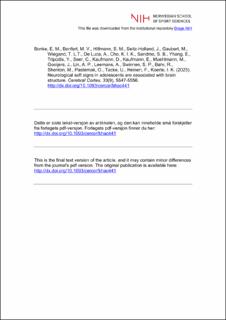| dc.contributor.author | Bonke, Elena M. | |
| dc.contributor.author | Bonfert, Michaela V. | |
| dc.contributor.author | Hillmann, Stefan M. | |
| dc.contributor.author | Seitz-Holland, Johanna | |
| dc.contributor.author | Gaubert, Malo | |
| dc.contributor.author | Wiegand, Tim L.T. | |
| dc.contributor.author | De Luca, Alberto | |
| dc.contributor.author | Cho, Kang Ik K. | |
| dc.contributor.author | Sandmo, Stian Bahr | |
| dc.contributor.author | Yhang, Eukyung | |
| dc.contributor.author | Tripodis, Yorghos | |
| dc.contributor.author | Seer, Caroline | |
| dc.contributor.author | Kaufmann, David | |
| dc.contributor.author | Kaufmann, Elisabeth | |
| dc.contributor.author | Muehlmann, Marc | |
| dc.contributor.author | Gooijers, Jolien | |
| dc.contributor.author | Lin, Alexander P. | |
| dc.contributor.author | Leemans, Alexander | |
| dc.contributor.author | Swinnen, Stephan P. | |
| dc.contributor.author | Bahr, Roald | |
| dc.contributor.author | Shenton, Martha | |
| dc.contributor.author | Pasternak, Ofer | |
| dc.contributor.author | Tacke, Uta | |
| dc.contributor.author | Heinen, Florian | |
| dc.contributor.author | Koerte, Inga K. | |
| dc.date.accessioned | 2023-11-17T10:33:29Z | |
| dc.date.available | 2023-11-17T10:33:29Z | |
| dc.date.created | 2022-12-06T14:44:47Z | |
| dc.date.issued | 2022 | |
| dc.identifier.citation | Cerebral Cortex. 2022, 33(9), 5547-5556. | en_US |
| dc.identifier.issn | 1047-3211 | |
| dc.identifier.uri | https://hdl.handle.net/11250/3103174 | |
| dc.description | I Brage finner du siste tekst-versjon av artikkelen, og den kan inneholde ubetydelige forskjeller fra forlagets pdf-versjon. Forlagets pdf-versjon finner du på academic.oup.com / In Brage you'll find the final text version of the articlacademic.oup.com | en_US |
| dc.description.abstract | Neurological soft signs (NSS) are minor deviations in motor performance. During childhood and adolescence, NSS are examined for functional motor phenotyping to describe development, to screen for comorbidities, and to identify developmental vulnerabilities. Here, we investigate underlying brain structure alterations in association with NSS in physically trained adolescents. Male adolescent athletes (n = 136, 13–16 years) underwent a standardized neurological examination including 28 tests grouped into 6 functional clusters. Non-optimal performance in at least 1 cluster was rated as NSS (NSS+ group). Participants underwent T1- and diffusion-weighted magnetic resonance imaging. Cortical volume, thickness, and local gyrification were calculated using Freesurfer. Measures of white matter microstructure (Free-water (FW), FW-corrected fractional anisotropy (FAt), axial and radial diffusivity (ADt, RDt)) were calculated using tract-based spatial statistics. General linear models with age and handedness as covariates were applied to assess differences between NSS+ and NSS− group. We found higher gyrification in a large cluster spanning the left superior frontal and parietal areas, and widespread lower FAt and higher RDt compared with the NSS− group. This study shows that NSS in adolescents are associated with brain structure alterations. Underlying mechanisms may include alterations in synaptic pruning and axon myelination, which are hallmark processes of brain maturation. | en_US |
| dc.language.iso | eng | en_US |
| dc.subject | brain development | en_US |
| dc.subject | gyrification | en_US |
| dc.subject | minor neurological dysfunction | en_US |
| dc.subject | motor development | en_US |
| dc.subject | neuroimaging | en_US |
| dc.title | Neurological soft signs in adolescents are associated with brain structure | en_US |
| dc.type | Peer reviewed | en_US |
| dc.type | Journal article | en_US |
| dc.description.version | acceptedVersion | en_US |
| dc.source.pagenumber | 5547-5556 | en_US |
| dc.source.volume | 33 | en_US |
| dc.source.journal | Cerebral Cortex | en_US |
| dc.source.issue | 9 | en_US |
| dc.identifier.doi | 10.1093/cercor/bhac441 | |
| dc.identifier.cristin | 2089527 | |
| dc.description.localcode | Institutt for idrettsmedisinske fag / Department of Sports Medicine | en_US |
| cristin.ispublished | true | |
| cristin.fulltext | postprint | |
| cristin.qualitycode | 2 | |
